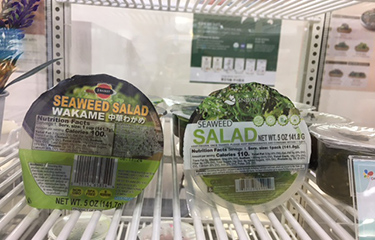New types of seaweed are becoming popular in Japan as “functional foods,” or “nutraceuticals,” foods with specific health benefits. This is partially because unlike in Western countries, where consumers prefer dietary supplements in the form of pills, Japanese prefer to directly consume foods that contain beneficial compounds.
Companies marketing seaweed products in Japan are aided by a law allowing medical claims in advertisements for foods when there are studies to support the claim. In 1991, the Japanese Ministry of Health, Labor, and Welfare established a regulatory system called Foods for Specified Health Use (FOSHU) to approve statements made on food labels concerning effects on the human body. The effectiveness and safety of food products applying for approval are scientifically evaluated by the Council of Pharmaceutical Affairs and Food Hygiene.
The slimy film found in many species of brown seaweed contains fucoidan, a sulphated polysaccharide that has been the subject of over 3,000 independent studies indicating it possesses antiviral, neuroprotective and immune-modulating effects.
While Japanese have long consumed various types of seaweed such as kelp (kombu in Japanese), sea lettuce (aosa), the red algae genus Pyropia (nori), Sargassum fusiforme (hijiki), and Undaria pinnatifida (wakame), species that contain high levels of fucoidan have gained in popularity lately.
Mozuku (Cladosiphon okamuranus) is a representative food of Okinawa, the prefecture with the longest lifespan in Japan. Unlike other seaweeds, which are often sold in dried form, mozuku is sold in sealed tray packs or plastic bags, sometimes with vinegar. It is distinctively slimy. Okinawa mozuku contains about 1 percent fucoidan, according to a 2018 study.
Mekabu is the lower portion (sporophyll) of wakame seaweed (Undaria pinnatifida) and is mainly farmed off the Sanriku area, which has a deeply intend coastline. Wakame is mainly cultivated for the leafy portion, which is sold dried to be rehydrated and used in soups and on salads. In 2020, the total wakame seaweed output of Japanese marine aquaculture amounted to approximately 53,000 metric tons. A 2006 study found the fucoidan percentage of dry U. pinnatifida sporophylls was 3.8 percent, while two locally cultivated forms yielded 1 and 2.1 percent.
While the levels are lower than that of akamoku, the industrial scale of wakame production makes this byproduct a more stable source for extracting fucoidan for supplements, so while it is also eaten directly in Japan as a functional food, most fucoidan pills that are becoming popular in Western countries derive their fucoidan from mekabu.
Akamoku (Sargassum horneri) was first cultivated commercially off Fukoka prefecture's Oshima Island iin the early 2000s. It is only in season for three months in late winter and early spring, when it has its highest fucoidan levels. It is washed three times to make it edible, boiled in both fresh and salt water, and then washed again while cooling. Finally, it is run through a mincer and packed in small plastic containers. Though it is reddish brown in its natural state, it turns green when boiled. A 2007 study found the fucoidan level of akamoku increases as it matures, topping out at between 6.60 and 8.31 percent.
Fukuoka-based Japan Wellness Research Institute, a subsidiary of the Tokyo-based mail-order marketing company Repriority Corp., was promoting the company’s aka-moku with soy sauce at the 24th Japan International Seafood & Technology Expo in August 2022.
“If you’re thinking about your health, mozuku is good, but akamoku is better!” Japan Wellness Research Institute Executive Manager Yasutaka Ishimatsu said at the show.
Photo courtesy of Chris Loew







